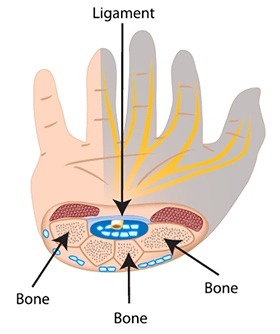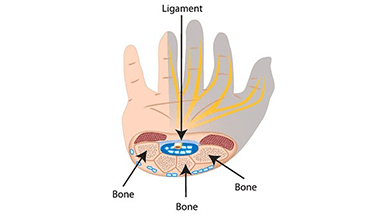Carpel Tunnel Syndrome is the result of the median nerve in your hand being compressed for some reason or another. This median nerve (one of the largest in the hand) is what allows you to feel sensations from your hand. When compressed, it can cause numbness, tingling, weakness, or muscle damage in the hand and fingers.
The area in your wrist where the nerve enters the hand is called the carpal tunnel – which gives the syndrome its name. Excessive pressure on the nerve can lead to.
 What Causes Carpel Tunnel Syndrome?
What Causes Carpel Tunnel Syndrome?
The carpal tunnel is generally narrow so any swelling can result in a pinched median nerve. Repetitive hand and wrist motions can attribute to Carpal Tunnel Syndrome in addition to other factors including: alcohol abuse, bone fractures and arthritis of the wrist, cyst or tumor that grows in the wrist, infections, obesity, and rheumatoid arthritis.
Carpal Tunnel Syndrome mostly affects people between the ages of 30 and 60-years-old and is three times more common in women than men.
How Do You Test for Carpel Tunnel Syndrome?
Early diagnosis and treatment is crucial to prevent permanent nerve damage. A physical evaluation of the hand and upper extremities can help to determine if pain is from daily activities or if it can be attributed to an underlying disorder. After a physical evaluation, the doctor can confirm the diagnosis through electrodiagnostic tests. These tests measure the speed with which nerves transmit impulses and can more accurately confirm signs of carpal tunnel syndrome.
Once a diagnosis is reached, there are several treatment options including surgical and non-surgical techniques.
Ways to Treat Carpal Tunnel Syndrome at Home
Before considering surgery, there are a few things you can try to help treat your symptoms at home. If your symptoms persist more than several consecutive days, it may be time to consult our hand specialist. Some tips to treat your symptoms at home include:
- Wearing a splint at night for a few weeks. If persistent, wear the splint during the day as well.
- Not sleeping on your wrists
- Performing stretching and strengthening exercises
- Placing warm and cold compresses on the area experiencing symptoms
- Trying cushioned mouse pads and keyboard drawers at the office
- Taking non-steroidal anti-inflammatory drugs (NSAIDs) such as ibuprofen or naproxen.
Non-Surgical Treatment Options for Carpel Tunnel Syndrome
When you see a hand specialist for your carpel tunnel syndrome issues, there are several options they may recommend before considering surgery. One option may be a combination of activity modification and splinting. If this doesn’t work, your physician may consider corticosteroid injections. With this option, the corticosteroid will be injected directly into the carpal tunnel area to provide pain relief. Note: injections may only temporarily relieve symptoms and results differ between each patient.
Surgical Treatment Options for Carpal Tunnel Syndrome
Generally, symptoms can improve without the need for surgery depending on the severity. However, more than half of cases eventually require surgery. Patients go home the same day following surgery and are back to work shortly thereafter, although a complete recovery may take several weeks or months. Some surgical options include:
- Carpal Tunnel Release is recommended for severe carpal tunnel syndrome or when symptoms are refractory to splints with or without injections. With this procedure, the surgeon cuts into the ligament that is pressing on the median nerve to relieve pressure. There are two different types of carpal tunnel release surgery:
- Open Release Surgery requires an incision followed by cutting the carpal ligament to enlarge the carpal tunnel.
- Endoscopic Surgery allows for minimal scaring and quicker recovery. During the procedure, the surgeon makes two incisions in the wrist and palm, inserts a camera attached to a tube, observes the tissue on a screen, and cuts the carpal ligament (the tissue that holds joints together).
Depending on the severity and how long the nerve compression has been present, surgery is usually successful at eliminating carpal tunnel syndrome symptoms.
